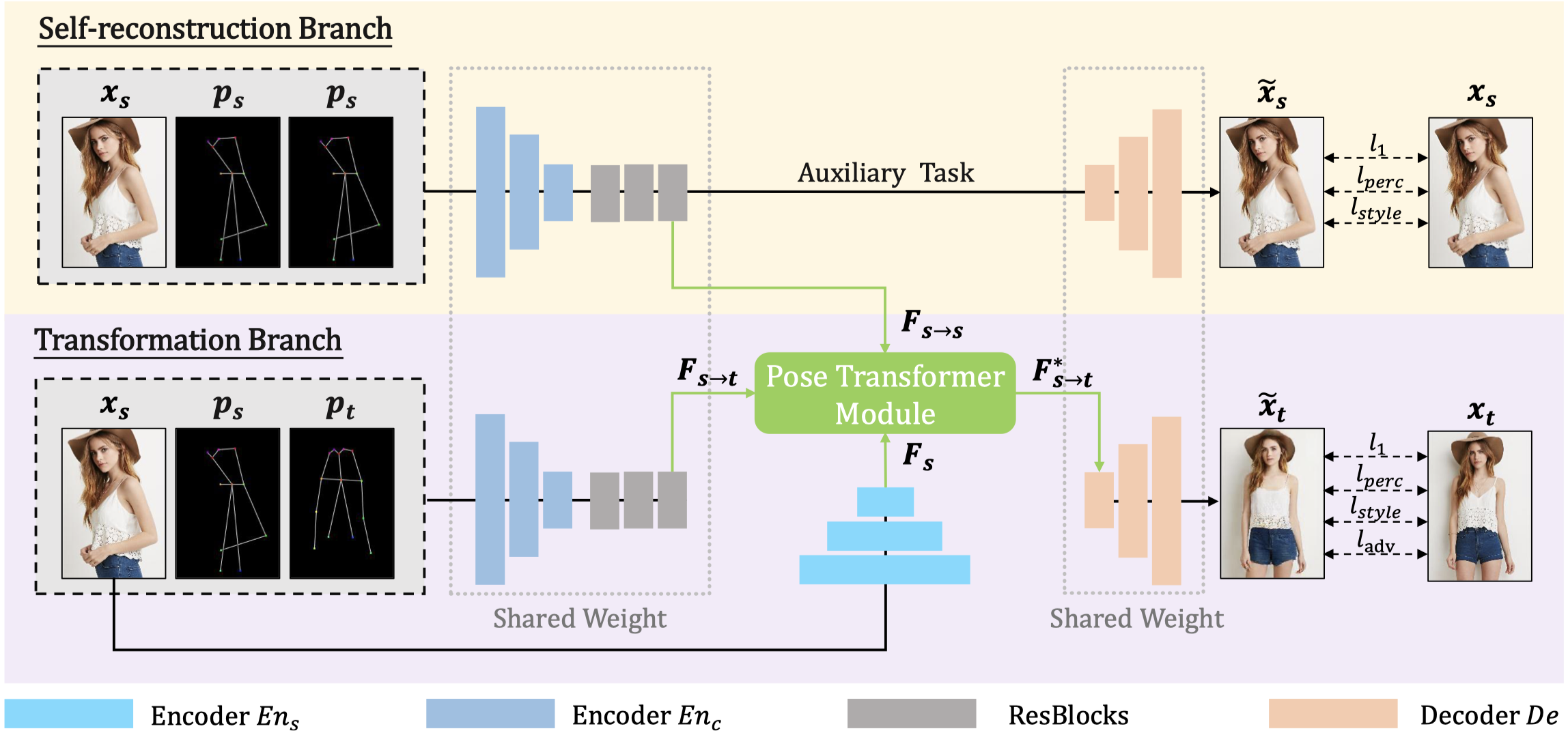Dual-task Pose Transformer Network
The source code for our paper "Exploring Dual-task Correlation for Pose Guided Person Image Generation“ (CVPR2022)
Get Start
1) Requirement
- Python 3.7.9
- Pytorch 1.7.1
- torchvision 0.8.2
- CUDA 11.1
- NVIDIA A100 40GB PCIe
2) Data Preperation
Following PATN, the dataset split files and extracted keypoints files can be obtained as follows:
DeepFashion
-
Download the DeepFashion dataset in-shop clothes retrival benchmark, and put them under the
./dataset/fashiondirectory. -
Download train/test pairs and train/test keypoints annotations from Google Drive, including fasion-resize-pairs-train.csv, fasion-resize-pairs-test.csv, fasion-resize-annotation-train.csv, fasion-resize-annotation-train.csv, train.lst, test.lst, and put them under the
./dataset/fashiondirectory. -
Split the raw image into the training set (
./dataset/fashion/train) and test set (./dataset/fashion/test):
python data/generate_fashion_datasets.py
Market1501
-
Download the Market1501 dataset from here. Rename bounding_box_train and bounding_box_test as train and test, and put them under the
./dataset/marketdirectory. -
Download train/test key points annotations from Google Drive including market-pairs-train.csv, market-pairs-test.csv, market-annotation-train.csv, market-annotation-train.csv. Put these files under the
./dataset/marketdirectory.
3) Train a model
DeepFashion
python train.py --name=DPTN_fashion --model=DPTN --dataset_mode=fashion --dataroot=./dataset/fashion --batchSize 32 --gpu_id=0
Market1501
python train.py --name=DPTN_market --model=DPTN --dataset_mode=market --dataroot=./dataset/market --dis_layer=3 --lambda_g=5 --lambda_rec 2 --t_s_ratio=0.8 --save_latest_freq=10400 --batchSize 32 --gpu_id=0
4) Test the model
You can directly download our test results from Google Drive: Deepfashion, Market1501.
DeepFashion
python test.py --name=DPTN_fashion --model=DPTN --dataset_mode=fashion --dataroot=./dataset/fashion --which_epoch latest --results_dir ./results/DPTN_fashion --batchSize 1 --gpu_id=0
Market1501
python test.py --name=DPTN_market --model=DPTN --dataset_mode=market --dataroot=./dataset/market --which_epoch latest --results_dir=./results/DPTN_market --batchSize 1 --gpu_id=0
5) Evaluation
We adopt SSIM, PSNR, FID and LPIPS for the evaluation.
DeepFashion
python -m metrics.metrics --gt_path=./dataset/fashion/test --distorated_path=./results/DPTN_fashion --fid_real_path=./dataset/fashion/train --name=./fashion
Market1501
python -m metrics.metrics --gt_path=./dataset/market/test --distorated_path=./results/DPTN_market --fid_real_path=./dataset/market/train --name=./market --market
6) Pre-trained Model
Our pre-trained model can be downloaded from Google Drive: Deepfashion, Market1501.
Citation
Acknowledgement
We build our project based on pix2pix. Some dataset preprocessing methods are derived from PATN.

 Do I need to continue training or do I stop to change the parameters.
Thank You!
Do I need to continue training or do I stop to change the parameters.
Thank You!